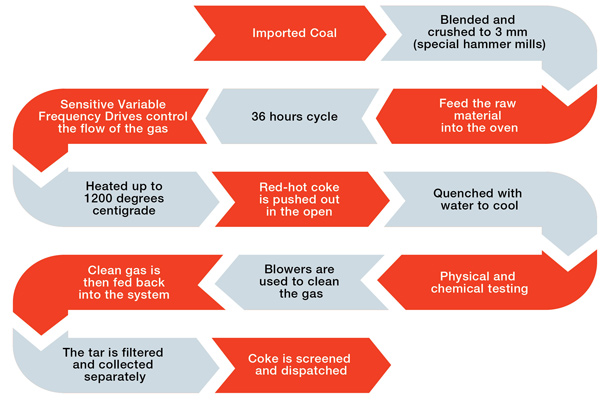| home | the green edge | gallery | ||
| about | careers | |||
| byproduct coke | contact us |
| the process |
|
|||||
 |
||||||
The manufacturing process used in the proposed project is the well known ‘Semet-Solvay’ process. Coal is imported to Kandla and Mundra ports and brought to the CEIL plants. The raw material (which is below 50mm size) is generally imported from Australia. This coal is fed into a hopper and transported via a conveyor to a hammer mill, and then blended and crushed to ensure 85-90%, (-)3 mm size in these special hammer mills. The plant has two batteries of 30 ovens each. The crushed and blended coal through conveyers is stored into a 600 MT bunker. There are two charging cars with a capacity of 9 MT each that help feed the raw material into the oven. Once the coal has been leveled, using specialized leveler machines, it is indirectly heated with coke oven gas, which is burnt inside heating walls in between the oven using preheated air. Volatile matter from coal inside the ovens is collected into the hydraulic main via ascension pipes and goose necks. There are spray nozzles inside the goose necks which quench the hot gas with ammonia liquor spray. The hydraulic main is half-filled with water and coal tar gets condensed along with moisture inside the main. From the hydraulic main, a stream of ammonia liquor and coal tar flows into a separator via a thick tar box and a long pipeline by gravity. Coal tar is stored in tanks and the ammonia liquor is recycled into the spray system. Part of it is stored and the rest is bled through a stripper to bring down ammonia level and the resultant liquor is reused in quenching or is recycled. A temperature of about 1150-1200 degree C is maintained in the heating walls on both sides of each oven to ensure uniform carbonization inside. Sensitive Variable Frequency Drives or VFDs along with imported blowers help control the flow of the gas into the flues and maintain optimum temperature levels. The carbonization cycle lasts about 33-36 hours. On completion of the cycle, evolution of volatile matter ceases and the oven is ready for pushing. After soaking for 10 minutes, the red-hot cake of coke is pushed out of the ovens with the help of ram cars after opening both ram side and coke side doors. The doors are again boxed up and coal is recharged into the ovens to repeat the next carbonization cycles. The red hot coke pushed out of the oven through |
guide cars, falls on an inclined wharf where it is quenched with water sprays. This quenched coke is then conveyed to an overhead storage bunker and loaded for storing or supply. Each time the ovens are charged, more gas is generated and cooled at different stages to produce tar. In the last stage, blowers are used to clean the gas off any tar particles, and the clean gas is then fed back into the system to heat the ovens. The tar is filtered and collected separately at different stages and dispatched to consumers as per orders. As per customer requirements, the coke is screened and dispatched through loading units with proper sealing arrangements to ensure that the best products reach the customer. Traditionally, coke-making technology is classified as recovery type and non-recovery type. We have earlier installed and operated non-recovery type plants at several locations on the Eastern part of India. It is a fact that coke produced by recovery technology is better than any non-recovery methods. Hence, setting up a recovery type plant was our Chairman’s dream. It required us to take a huge risk and enter unconquered frontiers in the industry.
|
|||||
| All contents © Carbon Edge Industries Limited (An ISO-9001:2015 Company). All Rights Reserved. |